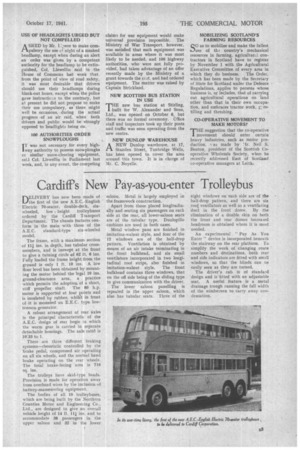Cardiff's New Pay-as-you-enter Trolleybus
Page 21

If you've noticed an error in this article please click here to report it so we can fix it.
DELIVERY has now been made of the first of the new A.E.C.-English Electric 70-seater, double-deck, six
wheeled, low height trolleybuses ordered by the Cardiff Transport Department. The chassis features conform in the main with those of the A.E.C. standard-type six-wheeled model.
The frame, with a maximum section of 111 ins, in depth, has tubular crossmembers, and is inswept at the front to give a turning circle of 62 ft. 6 ins, Fully loaded the frame height from the ground is only 1 ft. 10 ins. A low floor level has been obtained by mounting the motor behind the legal 10 ins. ground-clearance area, a practice which permits the adoption of a short, stiff propeller shaft. The 80 h.p. motor is supported at four Roints and is insulated by rubber, whilst in front of it is mounted an E.E.C. type lowtension generator.
A robust arrangement of rear axles is the principal characteristic of the A.E.C. design of rear bogie in which the worm gear is carried in separate detachable housings. The axle ratio is 10:33 to 1.
There are three •different braking systems—rheostatic controlled by the brake pedal, compressed air operating on all six wheels, and the normal hand brake operating on the rear wheels, The total brake-facing area is 716 sq. ins.
The trolleys have skid-type heads. Provision is made for operation away from overhead wires by the inclusion of battery-manoeuvring equipment.
The bodies of all 10 trolleybuses, which are being built by the Northern Counties Motor and Engineering Co., Ltd.. are designed to give an overall vehicle height of 14 ft. 111 ins, and to accommodate 38 passengers in the upper saloon and 32 in the lower saloon. Metal is largely employed in the framework construction.
Apart from those placed longitudinally and seating six passengers on each side at the rear, all lower-saloon seats are of the tubular type. Dunlopillo cushions are used in both cases.
Metal window pans are finished in imitation-walnut style, and four of the '12 windows are of the half-drop pattern. Ventilation is obtained by means of an air intake terminating in the front bulkhead, and six small ventilators incorporated in two longitudinal roof strips, also finished in imitation-walnut style. The front bulkhead contains three windows,that on the off side being of the sliding type to give communication with the.driver.
The lower " saloon panelling is repeated in the upper saloon, which also has tubular seats. Three of the
eight windows on each side are of the half-drop pattern, and there are six roof ventilators as well as a ventilating duct in the front dome. By the elimination of a double skin on both the front and rear domes increased headroom is obtained where it is most needed.
An experimental "Pay As You Enter " device is incorporated beneath the stairway on the rear platform. To simplify the work of changing route numbers and destinations, both rear and side indicators are fitted with small windows, so that the blinds can be easily seen as they are turned.
The driver's cab is of standard design and is fitted with an adjustable seat. A useful feature is a metal drainage trough running the full width of the windscreen to carry away condensation.




















































